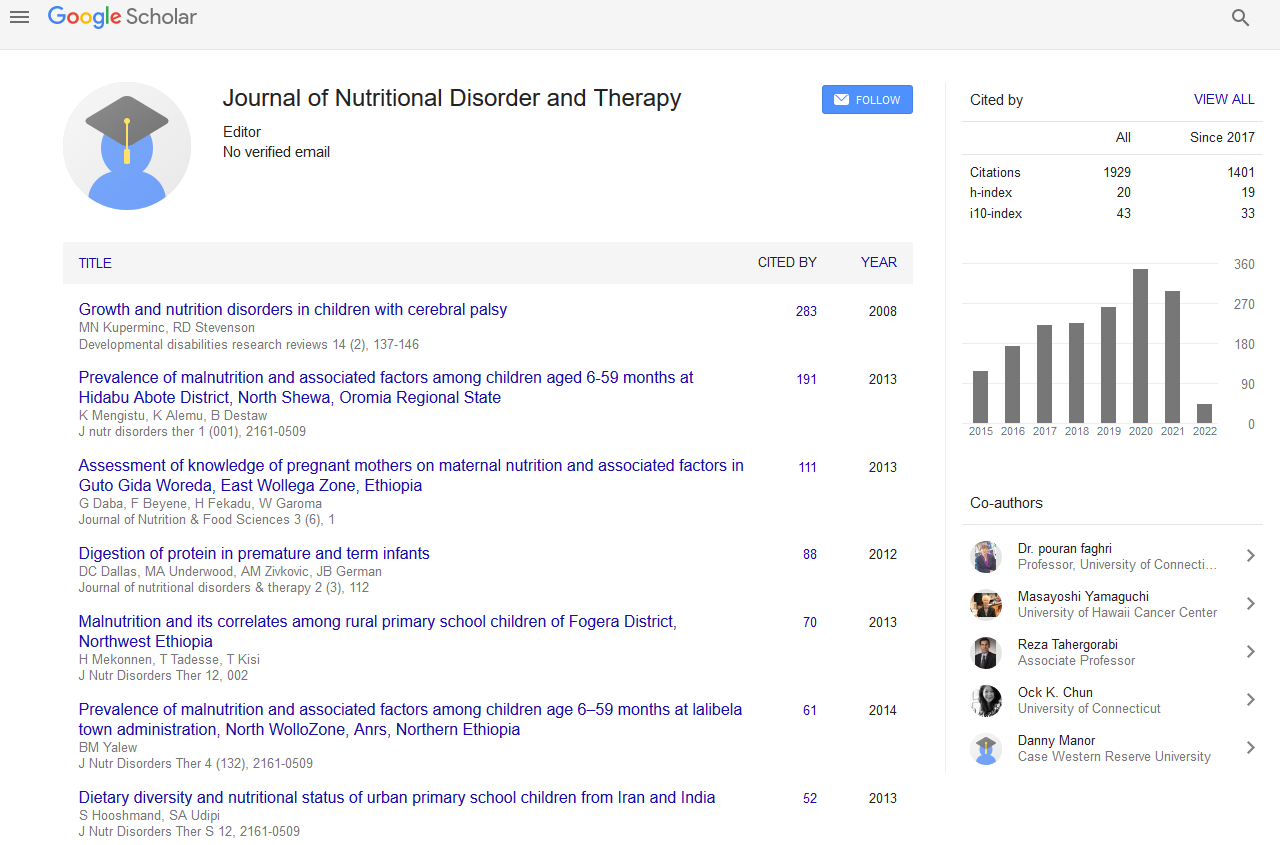Indexed In
- Open J Gate
- Genamics JournalSeek
- Academic Keys
- JournalTOCs
- Ulrich's Periodicals Directory
- RefSeek
- Hamdard University
- EBSCO A-Z
- OCLC- WorldCat
- Publons
- Geneva Foundation for Medical Education and Research
- Euro Pub
Useful Links
Share This Page
Journal Flyer

Open Access Journals
- Agri and Aquaculture
- Biochemistry
- Bioinformatics & Systems Biology
- Business & Management
- Chemistry
- Clinical Sciences
- Engineering
- Food & Nutrition
- General Science
- Genetics & Molecular Biology
- Immunology & Microbiology
- Medical Sciences
- Neuroscience & Psychology
- Nursing & Health Care
- Pharmaceutical Sciences
Abstract
Prevalence and Factors Associated with Stunting, Underweight and Wasting: A Community Based Cross Sectional Study among Children Age 6-59 Months at Lalibela Town, Northern Ethiopia
Birara M yalew, Amsalu F and Bikes D
Background: Children are most vulnerable to malnutrition in developing countries because of low dietary intakes, lack of appropriate care, and inequitable distribution of food within the household. Malnutrition remains one of the most common causes of morbidity and mortality among children throughout the world. Malnutrition In Ethiopia, in the form of stunting, underweight and wasting were identified as 44%, 29% and 10% and Amhara National region state 52%, 33.4% and 9.9%, respectively in children under five.
Objective: To determine the prevalence of malnutrition and associated factors among Children age 6-59 Months in Lalibela Town, Northern Ethiopia
Methods: A-Community based cross-sectional study was conducted from August 19 to September 13, 2012 in Lalibela town, Northern Ethiopia which includes both urban and rural settings. Data were collected from 844 households with children age 6-59 months using pre tested structured questionnaires and measuring weight and height of children. Bivariate and multivariate logistic regression analyses were used using SPSS version 16 computer software to see the relevant associations. Anthropometric data were also converted into indices of nutritional status using Emergency Nutrition Assessment for SMART special software, 2012.
Results: A total of 844 households were included in the study giving the response rate 100%. The prevalence of stunting, underweight and wasting were 47.3% (95%CI: 43.2-51.1), 25.6% (95%CI: 20.6-30.6) and 8.9% (95% CI: 6.9-10.2), respectively. Among the various socio-economic,demographic and child health and care practices characteristics considered, age of the child 11-23 months (AOR= 2.30; (95%CI: 1.28-4.12), Deworming status (AOR=2.19; (95% CI: 1.41-3.39), sex of the child(AOR= 0.75; (95% CI: 0.57-1.00) and breast feed the child still now(AOR= 0.40;(95% CI: 0.20-0.78) remained to be significantly associated with stunting. Middle wealth quintile to the households (AOR=0.51; (95%CI: 0.28-0.91), age of the child 23-35 months(AOR=2.29; (95%CI: 1.14-4.61), number of children aged 6-59 months in the household (AOR=1.61; (95%CI: 1.08-2.41) and giving honey to the child in the morning (AOR=1.52; (95%CI: 1.03-2.24) were remained to be significantly and independently associated withm underweight.
Conclusion: The prevalence rate of malnutrition in the study area was found high and this was coupled with association of many independent variables. This needs appropriate factor specific interventions.


